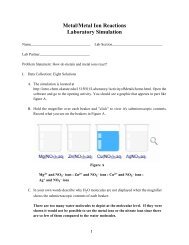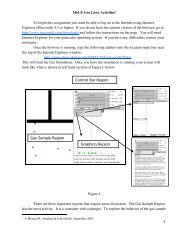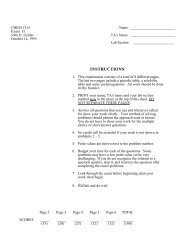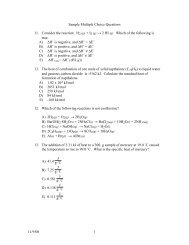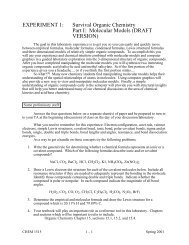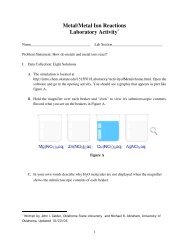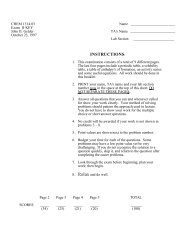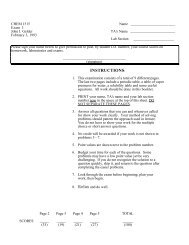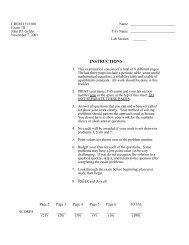Answers
Answers
Answers
Create successful ePaper yourself
Turn your PDF publications into a flip-book with our unique Google optimized e-Paper software.
CHEM 1014<br />
Exam II<br />
John II. Gelder<br />
October 21, 1999<br />
Name ________________________<br />
TA's Name ________________________<br />
Lab Section _______<br />
INSTRUCTIONS:<br />
1. This examination consists of a total of 6 different pages.<br />
The last page includes a periodic table and some useful<br />
information. All work should be done in this booklet.<br />
2. PRINT your name, TA's name and your lab section<br />
number now in the space at the top of this sheet. DO<br />
NOT SEPARATE THESE PAGES . You will receive 2<br />
points for knowing your TA’s name AND laboratory<br />
section number in which you are officially enrolled.<br />
3. Answer all questions that you can and whenever called<br />
for show your work clearly. Your method of solving<br />
problems should pattern the approach used in<br />
lecture/discussion. You do not have to show your work<br />
for the multiple choice (if any) or short answer<br />
questions.<br />
4. No credit will be awarded if your work is not shown in<br />
problems 3, 6b and 6c.<br />
5. Point values are shown next to the problem number.<br />
6. Budget your time for each of the questions. Some<br />
problems may have a low point value yet be very<br />
challenging. If you do not recognize the solution to a<br />
question quickly, skip it, and return to the question after<br />
completing the easier problems.<br />
7. Look through the exam before beginning; plan your<br />
work; then begin.<br />
8. Relax and do well.<br />
Page 2 Page 3 Page 4 TOTAL<br />
SCORES _____ _____ _____ ______<br />
(34) (36) (30) (100)
CHEM 1014 EXAM I PAGE 2<br />
(16) 1. Complete the following table with the missing information.<br />
(2 extra credit points)<br />
Symbol # protons # neutrons # electrons charge<br />
107<br />
46 Pd 2+ 46 61 44 2–<br />
15<br />
7 N 3– 7 8 10 –3<br />
241<br />
92 U 92 149 92 0<br />
95<br />
42 Mo 5+ 42 53 37 +5<br />
(6) 2. Balance each of the following equations.<br />
a) 4Ag(s) + 2H 2 S(g) + O 2 (g) → 2Ag 2 S(s) + 2H 2 O(l)<br />
b) MnO 2 (s) + 4HCl(aq) → Cl 2 (g) + MnCl 2 (aq) + 2H 2 O(l)<br />
(3) c) 4NH 3 (g) + 6NO(g) → 5N 2 (g) + 6H 2 O(g) BONUS: do not attempt until after<br />
completing the exam!)<br />
(12) 3. Write and balance the equation for each of the following.<br />
a) A formation equation for CCl 4 (g).<br />
2Cl 2 (g) + C(s) → CCl 4 (l)<br />
b) Write the formation for P 2 O 5 (s).<br />
P 4 (s) + 5O 2 (g) →<br />
2P 2 O 5 (s)<br />
c) A combustion reaction for hexane, C 7 H 14 (l).<br />
2C 7 H 14 (l) + 21O 2 (g) → 14CO 2 (g) + 14H 2 O(l)
CHEM 1014 EXAM I PAGE 3<br />
(24) 4. Calculate the mass, in grams, in each of the following;<br />
a) 5.67 mol C 7 H 14<br />
5.67 mol C 7 H 14 ⎝ ⎛ 98 g<br />
1 mol ⎠ ⎞ = 556 g C 7H 14<br />
b) 4.72 x 10 –6 mol NaCl<br />
4.72 x 10 –6 mol NaCl<br />
⎛58.5 g ⎞<br />
⎝ 1 mol ⎠<br />
= 2.76 x 10–4 g NaCl<br />
c) an atom of Ag<br />
⎛107.9 g Ag<br />
⎝ 1 mol<br />
⎞<br />
⎠<br />
⎝ ⎛ 1 mol<br />
6.02 x 10 ⎠ ⎞<br />
23 atom = 1.79 x 10–22 g per atom<br />
d) 3.92 x 10 24 molecules Br 2 .<br />
3.92 x 10 24 molecules Br<br />
⎛ 1 mol ⎞<br />
2 ⎝ 6.02 x 10 23 molecules ⎠ ⎝ ⎛ 160 g<br />
1 ⎠ ⎞<br />
mole<br />
= 1042 g<br />
(12) 5. Calculate the number of moles in each of the following;<br />
a) 7.00 x 10 –2 grams P 2 O 5<br />
7.00 x 10 –2 grams P 2 O 5 ⎝ ⎛ 1 mol<br />
142 g ⎠ ⎞ = 4.93 x 10–4 mol<br />
b) 8.15 x 10 21 atoms Na.<br />
8.15 x 10 21 atoms Na<br />
⎛ 1 mol<br />
⎝ 6.02 x 10 23 atom<br />
⎞<br />
⎠<br />
= 0.0135 mol
CHEM 1014 EXAM I PAGE 4<br />
(18) 6. Calculate each of the following;<br />
a) the number of fluorine atoms in one molecule of PF 5 .<br />
5 atoms of F in one molecule of PF 5 .<br />
b) the number of O atoms in 1 mol of O 2 .<br />
⎛6.02 x 10 23 O 2 molecule<br />
1 mol O 2 ⎝ 1 mol<br />
= 1.20 x 10 24 atoms O<br />
c) the number of N atoms in 2.5 mol of N 2 O 5 .<br />
⎞<br />
⎠<br />
⎝ ⎛ 2 O atoms<br />
1 O 2 molecule<br />
⎠ ⎞<br />
⎛6.02 x 10 23 N 2 O 5 molecule<br />
2.5 mol N 2 O 5 ⎝ 1 mol<br />
= 3.01 x 10 24 atoms N<br />
d) the number of Cl atoms in 3.00 x 10 –5 grams CCl 4 .<br />
⎞<br />
⎠<br />
⎝ ⎛ 2 N atoms<br />
1 N 2 O 5 molecule<br />
⎠ ⎞<br />
3.00 x 10 –5 grams CCl 4 ⎝ ⎛ 1 mol<br />
154 g CCl ⎠ ⎞<br />
4 ⎝ ⎛ 6.02 x 10 23 CCl 4 molecule<br />
⎠ ⎞<br />
1 mol<br />
⎛ 4 Cl atoms ⎞<br />
⎝1 CCl 4 molecule ⎠<br />
= 4.69 x 1017 atoms Cl<br />
(12) 7. Given the equation for the preparation of phosphoric acid H 3 PO 4 ,<br />
Calculate,<br />
P 4 O 10 (s) + 6H 2 O(l) → 4H 3 PO 4 (aq)<br />
a) the number of mol of water required to react with 2.5 mol of P 4 O 10 .<br />
2.5 mol of P 4 O 10 ⎝ ⎛ 6 mol H 2 O<br />
1 mol P ⎠ ⎞<br />
4 O 10<br />
= 15.0 mol H 2 O<br />
b) the number of mol of water required to produce 0.0455 grams of H 3 PO 4 .<br />
0.0455 grams of H 3 PO 4 ⎝ ⎛ 1 mol<br />
98 g H ⎠ ⎞ ⎛ 6 mol H 2 O ⎞<br />
3 PO 4 ⎝ 4 mol H 3 PO 4 ⎠<br />
= 6.94 x 10 –4 mol<br />
a) the number of grams of P 4 O 10 required to react with 45 g of H 2 O.<br />
45 grams of H 2 O<br />
⎝ ⎛ 1 mol<br />
18 g H ⎠ ⎞<br />
2 O ⎝ ⎛ 1 mol P 4 O 10<br />
6 mol H ⎠ ⎞<br />
2 O ⎝ ⎛ 284 g P 4 O 10<br />
1 mol P ⎠ ⎞<br />
4 O 10<br />
= 118 mol
CHEM 1014 EXAM I PAGE 5<br />
1<br />
2<br />
3<br />
4<br />
5<br />
6<br />
7<br />
IA<br />
1<br />
H<br />
1.008<br />
3<br />
Li<br />
6.94<br />
11<br />
IIA<br />
4<br />
Be<br />
9.01<br />
12<br />
Na Mg<br />
22.99 24.30<br />
19 20<br />
K<br />
Ca<br />
39.10 40.08<br />
37<br />
Rb Sr<br />
38<br />
85.47 87.62<br />
55 56<br />
Cs<br />
Ba<br />
132.9 137.3<br />
87 88<br />
Fr<br />
(223)<br />
Ra<br />
226.0<br />
IIIA IVA VA VIA VIIA 4.00<br />
5 6 7 8<br />
B C N O F<br />
9 10<br />
Ne<br />
10.81 12.01 14.01 16.00 19.00 20.18<br />
13 14 15 16 17 18<br />
IIIB IVB VB VIB VIIB VIII IB IIB 26.98 28.09 30.97 32.06 35.45 39.95<br />
21 22 23 24 25 26 27 28 29<br />
Sc Ti V Cr Mn Fe Co Ni Cu 30 31 32 33 34 35 36<br />
Zn Ga Ge As Se Br Kr<br />
44.96 47.88 50.94 52.00 54.94 55.85 58.93 58.69 63.55 65.38 69.72 72.59 74.92 78.96 79.90 83.80<br />
39<br />
Y Zr<br />
40 41 42 43 44 45 46 47 48 49 50 51 52 53 54<br />
Nb Mo Tc Ru Rh Pd Ag Cd In Sn Sb Te I Xe<br />
88.91 91.22 92.91 95.94 (98) 101.1 102.9 106.4 107.9 112.4 114.8 118.7 121.8 127.6 126.9 131.3<br />
57 72 73 74 76 77 78 79 81 82 83 84 85 86<br />
La<br />
Periodic Table of the Elements<br />
Hf<br />
Al<br />
Si<br />
P<br />
S<br />
Cl<br />
VIIIA<br />
2<br />
Ta W Re 75<br />
Os Ir Pt Au Hg 80<br />
Tl Pb Bi Po At Rn<br />
138.9 178.5 180.9 183.8 186.2 190.2 192.2 195.1 197.0 200.6 204.4 207.2 209.0 (209) (210)<br />
89 104 105 106 107 108 109<br />
Ac<br />
227.0<br />
Rf Db<br />
Sg<br />
Bh<br />
Hs Mt<br />
(261) (262) (263) (262) (265) (266)<br />
He<br />
Ar<br />
(222)<br />
Lanthanides<br />
Actinides<br />
58 59 60 61 62 63 64<br />
Ce Pr Nd Pm Sm Eu Gd 65 66 67 68 69 70 71<br />
Tb Dy Ho Er Tm Yb Lu<br />
140.1 140.9 144.2 (145) 150.4 152.0 157.2 158.9 162.5 164.9 167.3 168.9 173.0 175.0<br />
90 91 92 93 94 95 96<br />
Th Pa U Np Pu AmCm 97 98 99 100 101 102 103<br />
Bk Cf Es Fm Md No Lr<br />
232.0 231.0 238.0 237.0 (244) (243) (247) (247) (251) (252) (257) (258) (259) (260)<br />
Useful Information<br />
6.023 x 10 23<br />
mol =<br />
grams<br />
molar mass




